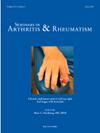Mortality and medical utilization in rheumatoid arthritis associated interstitial lung disease: A real-world, large-scale retrospective study comparing Janus kinase inhibitors and tumor necrosis factor inhibitors
IF 4.6
2区 医学
Q1 RHEUMATOLOGY
引用次数: 0
Abstract
Objective
The study is aimed to investigate the effectiveness of Janus kinase inhibitors (JAKi) on rheumatoid arthritis associated interstitial lung disease (RA-ILD) compared to tumor necrosis inhibitors (TNFi).
Methods
We applied a retrospective matched cohort analysis using the TriNetX database. The study included patients diagnosed with RA-ILD who received new prescriptions for JAKi or TNFi. The primary outcome was all-cause mortality, and secondary outcomes included medical utilizations. Hazard ratios (HRs) and Cox regression analyses were performed to assess these outcomes.
Results
Among 23,707 RA-ILD patients, 812 were selected for each treatment group (JAKi and TNFi) following propensity score matching. The JAKi group exhibited a higher all-cause mortality risk compared to the TNFi group (HR 1·458, 95 % CI: 1·136–1·870). JAKi group was also associated with a higher risk for hospitalization (HR 1·167, 95 % CI: 1·011–1·348), critical care services (HR 1·854, 95 % CI: 1·414–2·431), and mechanical ventilation (HR 2·609, 95 % CI: 1·718–3·962). Subgroup analysis indicated a heightened mortality risk in JAKi-treated patients aged over 65 years old (HR 1·815, 95 % CI: 1·316–2·503), and those with cardiovascular risk factors (HR 1·636, 95 % CI: 1·197–2·237). Sensitivity analysis yielded results that were not entirely consistent with the primary analysis, except for the subgroup aged over 65, where results remained aligned.
Conclusion
This real-world, large-scale cohort study indicated an association of higher mortality and medical utilizations in RA-ILD patients treated with JAKi compared to TNFi, especially among those over 65 years of age. These findings highlight the need for careful assessment when prescribing JAKi or TNFi for patients with RA-ILD.

求助全文
约1分钟内获得全文
求助全文
来源期刊
CiteScore
9.20
自引率
4.00%
发文量
176
审稿时长
46 days
期刊介绍:
Seminars in Arthritis and Rheumatism provides access to the highest-quality clinical, therapeutic and translational research about arthritis, rheumatology and musculoskeletal disorders that affect the joints and connective tissue. Each bimonthly issue includes articles giving you the latest diagnostic criteria, consensus statements, systematic reviews and meta-analyses as well as clinical and translational research studies. Read this journal for the latest groundbreaking research and to gain insights from scientists and clinicians on the management and treatment of musculoskeletal and autoimmune rheumatologic diseases. The journal is of interest to rheumatologists, orthopedic surgeons, internal medicine physicians, immunologists and specialists in bone and mineral metabolism.

 求助内容:
求助内容: 应助结果提醒方式:
应助结果提醒方式:


